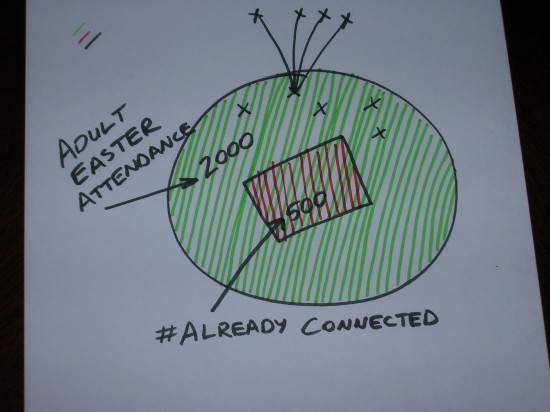3 Clues That Will Help You Design Your Small Group Ministry
 All of us have a level of interest in putting our own spin on the design of our small group ministries. Our designs include things like:
All of us have a level of interest in putting our own spin on the design of our small group ministries. Our designs include things like:
- who can be a group leader (and how they become one)
- leader expectations
- how leader development works (i.e., is there training, is there a coach, etc.)
- how you join a group
- what material a group can use
- what are the things a group does together (i.e., love, learn, serve, pray, etc.)
- how long a group can stay together
- etc.
Some of us are dreamers. We really want to see our own hopes, beliefs, and ambitions come true. We have very personal stories that shape what we hope, both for unconnected people and for stuck followers of Jesus.
And the stuff of our past (present and future) plays a role in the desire for the small group ministry that we lead.
Others of us are more pragmatic. Give us an off-the-shelf solution, a manual for how to build a North Point or a Saddleback small group ministry.
We just want to be effective and it's not really personal.
And many of us are somewhere in between. We do have stories that shape our small group ministry hopes and beliefs and ambitions, but we'd love at least a little bit of an inside tip on how to build a thriving small group ministry.
Personally...that's me. And it probably is closer to you.
3 Clues That Will Help You Design Your Small Group Ministry
I am a practitioner. I am a designer. And I'm a little bit of a mad scientist.
Over the years I've identified 3 clues that will help you design (or choose) your small group ministry model.
Here's what I discovered.
The First Clue
 Can I show you what I think ought to be your first clue when designing the right small group model or system or strategy for your church?
Can I show you what I think ought to be your first clue when designing the right small group model or system or strategy for your church?
This might surprise you, but I really do believe there is a best system for you. How can you figure out what is best? I have three clues. Here's the first one.
If you want to build a thriving small group ministry, the first thing you need is an accurate understanding of how many adults are already genuinely connected and how many are unconnected.
If you want to build a thriving small group ministry, the first thing you need is an accurate understanding of how many adults are already genuinely connected and how many are unconnected. Click To Tweet
The first thing you need is an accurate understanding
Some will argue that before you need that info you need to clarify what a win is for your small group ministry. They have an argument. They may be right. But I think this comes first.
Here's how I go about it:
Step One: Figure out the adult attendance at your last Easter or Christmas Eve service(s). We're not looking for your average weekend adult attendance. We're looking intentionally at your holiday attendance because it is almost always a better indication of your crowd number. The crowd indicates the number of people who consider your church to be their church.
This is a really big understanding. While there are some churches that have almost zero appreciable difference in their Easter and regular attendance...they're not the norm. There is normally a bump of 15 to 25% in adult attendance. The size of your crowd is what makes that happen. Some churches can have a bump as high as 30 to 50% on Easter. The higher your outreach element, the higher the bump.
Important: I draw a circle and write down the Easter number (see the diagram above).
Step Two: The second thing I do is draw a square to represent the number of people at your church who are genuinely connected. For me, that is determined by a couple factors and neither of them are easily measured (read: you'll have to guesstimate this number). They are genuinely connected when the meet these two factors:
- First, if something happens to them (or a member of their family), someone else hears about it within 24-48 hours without anyone calling the church (in other words, they lose their job, their marriage falls apart, a child is sick, etc.). We're not talking gossip. We're talking connection. Obviously, they'd need to pretty connected to have this happen. Groups that meet twice a month rarely have this level of connection. Groups that meet weekly but don't connect offline rarely have this level of connection. How many of your adults do you think fit inside the square?
- Second, there is someone regularly building into them from a spiritual standpoint and it's not the pastor. Could be a group leader or member. Might be a ministry team leader or member. But there is someone involved enough in their life to catch them when they're growing (I saw the way you encouraged Johnny today) or challenge them when they're slipping (I overheard you talking with your wife and I know you're working on being kind). How many of your adults have that second factor going for them?
Important: Write that number inside the square.
Step Three: There are a number of questions that must be asked once you see these numbers for yourself.
- When you subtract the number in the square from the number in the circle...what do you come up with? That's the real unconnected number. Some churches want to take their average adult weekend attendance and subtract the number of adults in groups to come up with the percentage connected. Don't fall for that. That's a fake number.
- If you divide that number by 10, what do you come up with? That's the number of groups you need to create to connect the unconnected today.
- Where will you find enough leaders to care for the number of unconnected people you've got? This tells you whether your current system of leader identification and qualification is viable.
Helpful diagram? Of course...it raises a lot of questions. What are the answers? Clue #2 will help with that.
The Second Clue
There was a line in the previous section that I really want you to catch. I really believe there is a best system for your church.
I don't mean a problem-free system (see my article on the pursuit of problem-free if you're unfamiliar with this learning). I mean, there is a system that will best fit your culture (or the one you aspire to cultivate).
Earlier I wrote that the first clue when designing your small group system was an understanding of how many adults are already genuinely connected and how many are unconnected. I believe this is crucial information as you develop the design for your small group system.
Clue #2: Build Next Steps for Every Participant and First Steps for Their Friends
 We've talked about Saddleback's concentric circles in the past. This diagram is a great way to understand several different aspects of ministry. Seriously. It's amazing. But only if you really get it.
We've talked about Saddleback's concentric circles in the past. This diagram is a great way to understand several different aspects of ministry. Seriously. It's amazing. But only if you really get it.
Here's how it works for me. These are the definitions:
- Community: These are people who don't yet attend your church. They may know about you. They may have friends that attend. But they're not connected in any way to what you're doing.
- Crowd: The crowd represents people who may only come a few times a year. They may only come twice a year (Christmas and Easter). Still, while thinly connected to your church, they consider your church to be their church.
- Congregation: These are people that attend more regularly. They may come 2 or 3 times a month. Note: Their attendance may have slipped during COVID-19 and they may now come once or twice a month. They may serve occasionally(for instance, when you add greeters for Easter). They are often in a small group, but their involvement may have decreased here too. They typically give but it's more a tip than a tithe. Mostly, they're more frequent consumers of what you're producing.
- Committed: These folks are very involved, are actively serving in a ministry, are regular givers, and still attend most Sundays. They may be playing a leadership role on a team or lead a small group. They've moved out of the consumer role into a contributor role, but they're more often on the team than leading the team.
- Core: This last group is generally the most mature spiritually, are often sacrificial givers, and are playing key roles on boards, teams, and ministries. They are most definitely contributors...in every way imaginable (with time, talent and treasure).
Note: For most churches, while the size of the community was unaffected by COVID-19 everything from the crowd to the core has shrunk in size. In many cases, the crowd and community segments have suffered the greatest loss while the committed and core number are down but not to the same degree.
What does this have to do with designing your small group system?
While you probably already get this, a little review may go a long way. Here's what I want you to catch today:
- Your average weekly adult attendance is a mix. It's made up of people from the core, committed, congregation and crowd. All of them consider your church to be theirs.
- Every church will have its own unique blend of the four circles. Some churches will have huge crowd constituencies. This is often the explanation of Easter attendance of 150% or even 200% of average. Other churches will hardly see a bump (commonly a reflection of a much smaller crowd segment).
- Pay attention to the fact that specific activities (or topics) will appeal to less committed, spiritual beginners, while other activities (or topics) will more readily appeal to more committed, more mature believers.
- Be careful who you're listening to when you're evaluating the effectiveness of an event or curriculum. It's very common for a critical review from an unintended participant to skew the feedback.
- An unexpected reality in the concentric circles diagram is that the deeper into the environment a person moves, the more connected within they become. At the same time, they become less connected to those outside. With few exceptions, folks in the crowd have more connections in the community than anyone else. That's a very significant detail when you're designing your host recruitment strategy. It's also a very important reason that the x-factor is near the edge.
An unexpected reality in the concentric circles diagram is that the deeper into the environment a person moves, the more connected within they become. At the same time, they become less connected to those outside. Click To Tweet
Key Takeaway: You must develop an understanding of the kind of people that make up each of the segments. I often suggest identifying a person or two from each segment. Getting to know them, learning to anticipate their needs and interests, will help you design a system that offers next steps for all of them and first steps for their friends.
Clue #3 Every small group ministry system comes with its own unique set of problems.
Every small group ministry system comes with its own unique set of problems. None of them are problem-free, and this is true whether it is an off-the-shelf system or has a custom and unique design.
Every small group ministry system comes with its own unique set of problems. None of them are problem-free, and this is true whether it is an off-the-shelf system or has a custom and unique design. Click To Tweet
This is a huge realization and essential for you to come to grips with the fact that every system, every strategy, has a set of problems that come with it.
At some level, we’re all in a kind of denial. I’ve come to expect that all of us secretly believe that our preferred system is problem-free or nearly problem-free, when the truth is, we’ve never really given the situation a thorough and passion-free examination.
At some level, we’re all in a kind of denial. I’ve come to expect that all of us secretly believe that our preferred system is problem-free or nearly problem-free, when the truth is, we’ve never really given the situation a thorough… Click To Tweet
Can I walk you through this important exercise? Here’s an example of a thorough and passion-free examination.
If you’ve been a reader here for any length of time, you know that I am a huge fan of the church-wide campaign strategy for launching groups. I believe it is the most effective way to launch. But it’s not problem-free. Let me show you my own assessment of the primary weaknesses (problems) of the church-wide campaign strategy.
Church-Wide Campaign Strategy Problems:
- When you optimize the host ask, you will get some host volunteers that won’t meet even the lowest criteria. While you've built your strategy with the guideline that "hosts fill their own group" and you won't be supplying members, there will still be some host volunteers will have no one they can (or will) invite. You’ll have to actually talk with some of them and help them find another way to participate.
- To maximize the response requires narrowing the focus during the 4 to 6 weeks just prior to the launch of the campaign message series. Because late September/early October is the best window to run the series, it means asking every other ministry to promote their baby another way.
- Your senior pastor is absolutely the best person to make the host ask. Incorporating the ask into their sermon is the very best way to get a response. Because not everyone attends every week, the ask must be made 2 or 3 weeks in a row. It’s not unusual for senior pastors to resist being the one to ask. It’s very common for them to not want to do it during their message. If they haven’t resisted being the one to ask and they’ve been willing to incorporate it into their message…they will almost certainly frown on the idea of doing it 2 or 3 weeks in a row.
- The message series with the broadest outreach appeal are sometimes on topics that your senior pastor is less comfortable doing (i.e., Rick Warren campaigns like What On Earth Am I Here For? or Transformed: How God Changes You, etc.).
- The message series your pastor may want to do aren’t on the easy end of the easy/hard continuum (i.e., they’re on a subject that is great for the usual suspects…but not for the folks that really need to get connected).
Disclosure: These are just the first 5 that came to my mind. There are certainly others. Many others. But, and this is where you need to be sharp and pull in a team to play along, there are ways to mitigate every one of these problems. I’ve chosen the church-wide campaign strategy as the primary way we launch new groups because I’d rather have these problems that any other set (here’s my top 10 articles on launching a church-wide campaign).
Wise leaders simply choose the set of problems they’d rather have.
Conclusion:
While there are certainly other clues that will help you design your small group ministry, these are the three I find myself explaining to small group pastors and senior pastors. Whether they come up during a coaching call or a conversation after a conference workshop, these are at the heart of what you need to understand if you want more than an off-the-shelf small group ministry.
Need more help?
I developed How to Build a Thriving Small Group Ministry, my four part video course, to flesh out my most popular conference workshop. Here's what you'll gain from this course:
- An accurate diagnosis of your current situation (limiting factors, barriers, untapped resources and advantages)
- The tools that will help you identify future opportunities with the most upside.
- Resources that help you craft a preferred future that will help your ministry move in the right direction
- The strategies that will help you move in the direction of your preferred future and stay on course.


